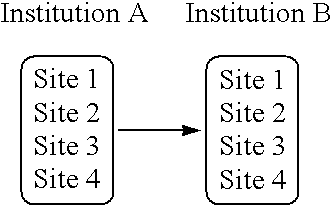Credit limit storage in an anonymous trading system
- Summary
- Abstract
- Description
- Claims
- Application Information
AI Technical Summary
Benefits of technology
Problems solved by technology
Method used
Image
Examples
example 1
[0095] Local-Global
[0096] Local-Global relationships are common in the existing anonymous trading systems described previously, partly because of the limitations of those systems which require institutions to allocate credit limits between individual trading floors and each counterparty with which they want to trade. This has led to some banks allocating spot FX credit lines based on this grouping relationship to bring them into line with the inflexible requirements of the prior art systems. Other banks have set aside portions of their credit and allocated it using local-global credit purely for trading on anonymous systems. Such banks use other credit is relationships for their remaining operations.
EXAMPLE 2
[0097] Global-Global
[0098] In this model, Institution A extends credit for all its trading floors to all trading floors of Institution B. This means that the amount of trading any given floor of Institution A can do with Institution B is affected by the amount of trading with In...
example 2
[0099] Global Global
[0100] Global-Global credit relationships are the most fundamental or basic type.
EXAMPLE 3
[0101] Global-Local
[0102] In this model, the whole of Institution A extends a combined line of credit to individual floors of Institution B. this may be appropriate where Institution A considers that Institution B is not uniformly trustworthy; there may be one particular trading floor with whom they are reluctant to extend large lines of credit. Alternatively, the country in which a trading floor is located may need to be considered as a special case or a trading floor may not have an appropriate legal status within Institution B.
3 3
example 3
[0103] Global-Local
EXAMPLE 4
[0104] Local-Local
[0105] In some situations, Institution A may allow individual trading floors to extend lines of credit to individual trading floors of Institution B. this occurs for example, in emerging markets or exotic locations where trading is done solely from the branch of Institution A in that country to the branch of Institution B in that country. Typically, there is no other interaction between Institution A and these branches of Institution B.
4 4
PUM
 Login to View More
Login to View More Abstract
Description
Claims
Application Information
 Login to View More
Login to View More - R&D
- Intellectual Property
- Life Sciences
- Materials
- Tech Scout
- Unparalleled Data Quality
- Higher Quality Content
- 60% Fewer Hallucinations
Browse by: Latest US Patents, China's latest patents, Technical Efficacy Thesaurus, Application Domain, Technology Topic, Popular Technical Reports.
© 2025 PatSnap. All rights reserved.Legal|Privacy policy|Modern Slavery Act Transparency Statement|Sitemap|About US| Contact US: help@patsnap.com



